Schedule a Call
Get started with your organic growth journey!



Get insights on AI, productivity, and the future of work.


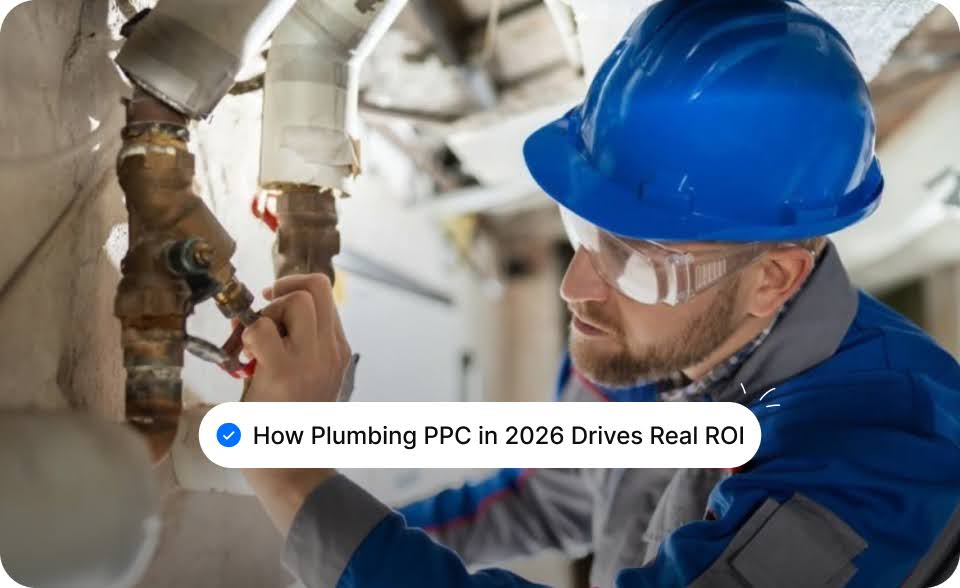
If you're a plumber looking to reach more customers online, pay-per-click (PPC) advertising can help. With plumber PPC, you don’t have to wait for customers to find you; instead, you show up when they're actively searching for services like yours.
It's a straightforward way to get your business in front of potential clients. Plus, with PPC, you only pay when someone clicks on your ad, making it a cost-effective way to get more calls and bookings.
For plumbing businesses that want to grow their online presence, PPC is an easy and effective solution.
Plumbing PPC, or pay-per-click advertising, is a simple way to get your business in front of people who actually need a plumber right now. Your ad appears when someone types something like “emergency plumber near me,” and you only pay when they click on it.
No wasted spend, no assuming who will see your message.
PPC works especially well for plumbers because most plumbing jobs aren’t planned. People search online the moment a pipe bursts, the sink stops draining, or the water heater gives up. With PPC, your business shows up at the exact moment they’re ready to call someone. That means:
To get the most out of your PPC efforts and ensure long-term success, you must consider AI-assisted SEO services that can help drive organic traffic and optimize your strategy for even better results.
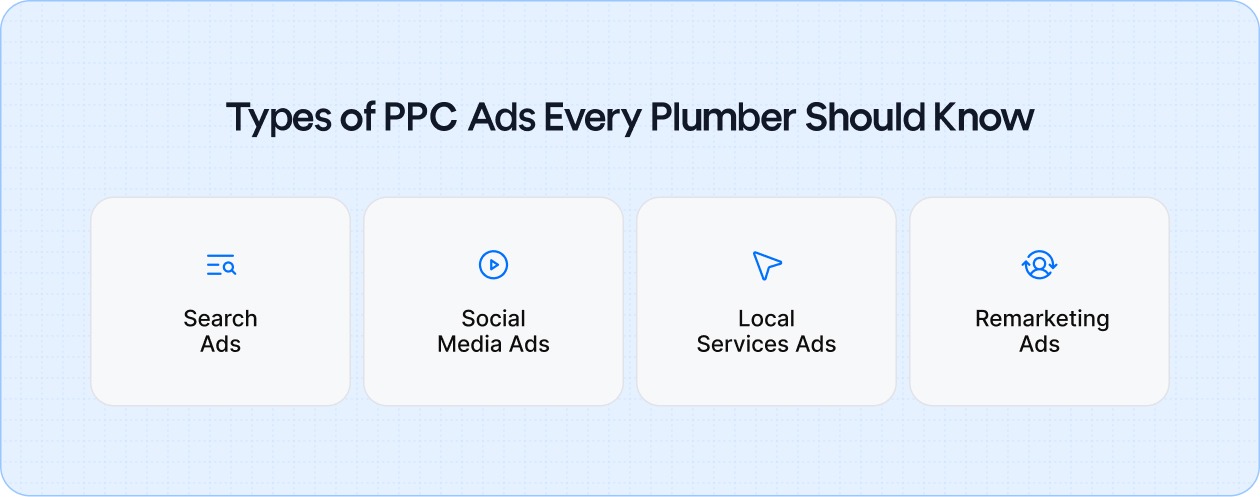
When it comes to PPC ads, there are different types you can use to help your plumbing business gain visibility, attract leads, and grow. Each type targets a unique audience and serves a specific purpose in your marketing strategy.
Let’s take a look at the key types of PPC ads every plumber should consider:
Search ads are perfect for reaching customers who are actively looking for plumbing services right now. These ads appear at the top of Google search results when someone types in high-intent keywords like "plumber near me" or "emergency pipe repair Chicago".
These searchers are looking for help and are ready to hire.
Why it works:
Social media ads, especially on platforms like Facebook, Instagram, TikTok and YouTube, are perfect for getting your business in front of potential customers, even if they aren’t actively searching for a plumber.
These ads allow you to build brand awareness, showcase your work, and engage with your community.
Why it works:
Local Services Ads (LSAs) are an excellent tool for plumbers. These ads appear at the top of Google search results when people search for plumbing services in your area.
The key advantage is that you only pay when someone contacts you directly, either by phone or message.
Why it works:
Remarketing ads allow you to target people who have previously visited your website or interacted with your ads but didn’t take action. These ads keep your plumbing business top-of-mind, giving those visitors another chance to convert into customers.
Why it works:
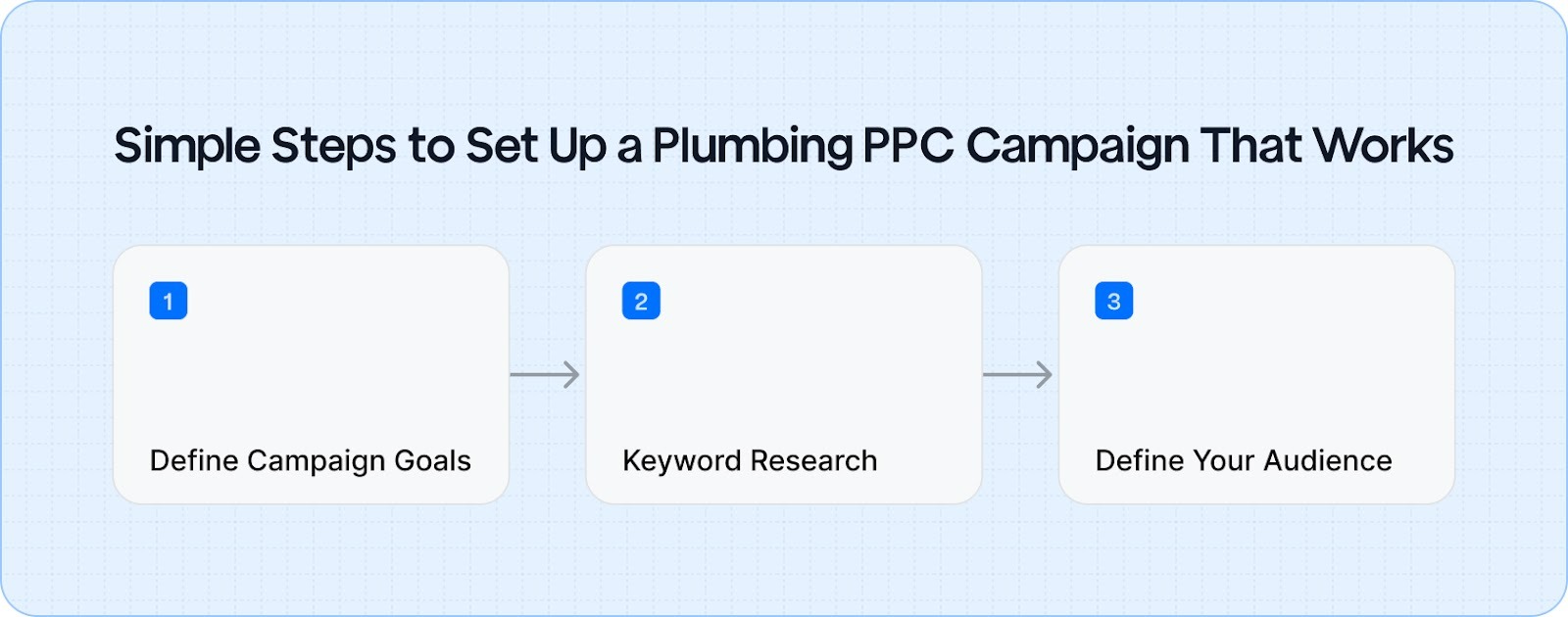
Follow these steps to create a campaign that drives results:
Before diving into your ads, decide what you want to achieve. Are you looking for more calls? Want to generate leads directly? Or maybe your goal is to increase brand awareness? By defining your goals, you can shape every part of your campaign to serve your business objectives.
Having a clear goal means you can measure success and adjust along the way. You'll quickly see what's working, what's not, and where to focus your budget for the best results.
Effective keyword selection is crucial for your PPC campaign’s success. Focusing on the right keywords ensures your ads reach the people who need plumbing services most.
Here's how to do it right:
Long-tail keywords like “emergency plumber near me” or “drain repair in Boston” are more specific and show clear intent. These customers are ready to book, and these keywords usually have less competition, making them more cost-effective.
Target keywords that include your service area. Phrases like “plumber in Dallas” help you connect with people looking for services in your area, increasing conversion rates and reducing wasted spend.
Use specific keywords related to the exact plumbing services you offer, such as “pipe leak repair” or “water heater installation.” This ensures your ads show up for people looking for exactly what you provide.
Look at the keywords your competitors are targeting. This can reveal opportunities to target underused keywords and areas where your competition is excelling.
Target keywords that reflect seasonal plumbing needs, like “frozen pipe repair in winter.” This keeps your business top-of-mind when customers need you most.

Targeting the right audience is key to making your PPC ads work for you. Geo-targeting allows you to focus your ads on people in your local area, so you’re only paying for clicks from potential customers who are close enough to use your services.
Time-of-day adjustments let you control when your ads show up, such as during peak hours for emergency plumbing issues or in the early morning for routine repairs.
This helps make sure you’re not wasting money on ads when people aren’t likely to be looking for plumbing services.
By narrowing your focus to the right local area and time frame, you can ensure your ad spend is as efficient as possible, getting in front of people when they need you most.
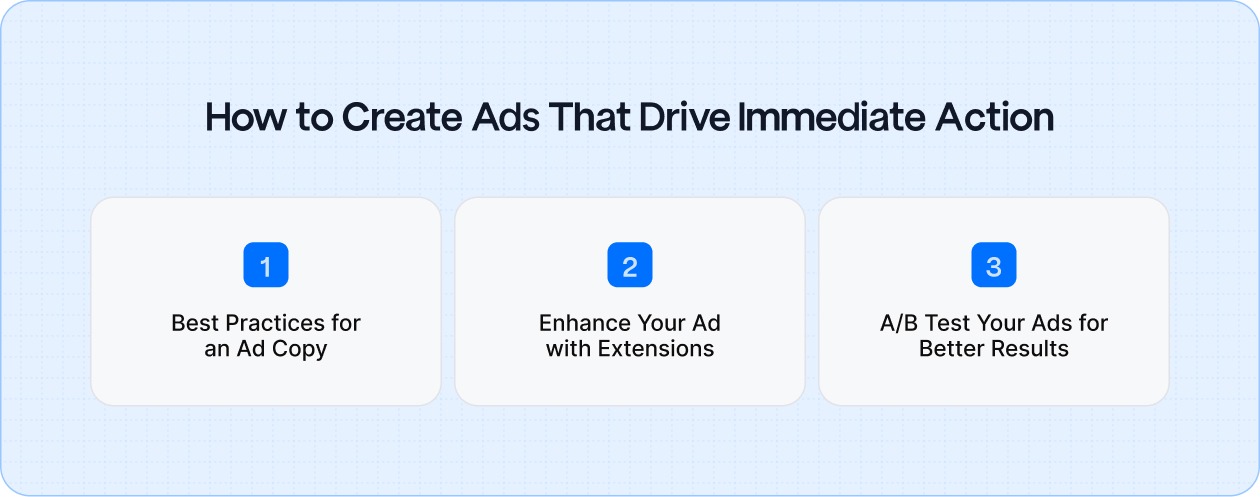
Creating PPC ads that stand out in a crowded space can be the difference between getting a click and getting lost in the shuffle. It’s about making sure your ads speak directly to people’s needs and encourage them to take action.
Here’s how to create ads that work:
When potential customers search for plumbing services, they’re often in a time-sensitive situation. Maybe their pipes just burst, or their water heater stopped working in the middle of the night.
This is where your ad copy needs to speak directly to their urgency. Use words that evoke a sense of immediacy, like “24/7 Emergency Plumbing, Call Now” or “Same-Day Service Available, Call Us Today”.
Why it works:
Remember, you’re offering a solution to a problem. The clearer and more urgent your message, the more likely people are to call.
Ad extensions are a simple and powerful way to provide more information in your ad without cluttering the main copy. These extra details, like phone numbers, location, and site links, make it easier for potential customers to reach you and find exactly what they need.
Why it works: These extensions add more touchpoints for customers to engage with your ad. The more accessible and informative your ad is, the more likely people are to click through.
By testing different variations of your ads, including headlines, calls-to-action (CTAs), and visuals, you can discover which versions resonate most with your target audience.
What you should test:
Why it works: By testing and optimizing your ads, you can ensure that each ad you run is fine-tuned to perform its best. Even small tweaks can make a big difference in conversion rates.
A successful PPC campaign begins with smart budgeting and effective bidding strategies. By setting realistic goals and continuously optimizing your keywords, you can make sure every dollar spent drives meaningful results for your plumbing business.
Knowing your budget range is key to effective PPC. For most plumbing businesses, this can range from $1,500 to $10,000 per month, depending on size and competition. Start small, track results, and scale based on what works.
Choose the right bidding strategy to get the best value for your spend.
Monitor which keywords are bringing in quality leads and increase your budget for those high performers. This ensures your ad spend is focused on what drives results.
When it comes to managing your PPC campaigns, the decision to handle them in-house or bring in a professional can significantly impact your results. For small plumbing businesses, DIY PPC can be a cost-effective solution if you're willing to dedicate time and effort.
However, as your business grows and your campaigns become more complex, you might find that expert help can deliver more efficient and effective results.
Here's a breakdown of the key differences to help you decide which option best suits your needs.
While PPC is effective for immediate visibility, building a strong foundation with SEO-driven content can enhance your results over time. Creating high-quality, optimized content that ranks well in search engines can naturally draw more traffic to your website, reducing your reliance on paid ads.
This long-term strategy strengthens your overall online presence, increasing the chances that paid clicks lead to conversions.
PPC for plumbers can deliver fast results by turning clicks into valuable leads. With the right ad types, a clear budget, and continuous optimization, your plumbing business can experience real growth.
PPC helps you connect with local customers who are actively looking for plumbing services, and with regular adjustments, you can make sure your investment continues to pay off.
A well-planned plumbing PPC campaign ensures you’re getting the most out of your advertising efforts. Starting out or aiming to expand, taking a strategic approach will help you reach more qualified customers.
A1. PPC (Pay-Per-Click) for plumbing businesses involves running ads that target potential customers searching for plumbing services. You only pay when someone clicks on your ad, making it an efficient way to generate leads.
A2. Focus on location-based long-tail keywords like "emergency plumber near me". These types of keywords attract high-intent customers actively looking for services.
A3. The budget can vary, but most plumbing businesses spend between $1,500 to $10,000 per month, depending on their location, competition, and goals. Start with a smaller budget and scale as you see results.
A4. Yes, you can run a DIY campaign, but managing it effectively requires constant optimization, keyword research, and tracking. As your business grows, hiring an expert can help you maximize ROI.
A5. Search Ads, Local Services Ads (LSAs), and Social Media Ads are highly effective. Search Ads target customers actively searching for plumbing services, while LSAs help with local, high-intent leads.
A6. Use tools like Google Analytics to monitor key metrics such as click-through rate (CTR), conversion rate, and cost per lead (CPL). Tracking these metrics allows you to adjust your strategy and improve performance.
A7. First, review your ad copy, keywords, and landing pages to ensure they align with customer intent. Consider adjusting your bids, testing new keywords, or using remarketing ads to reach past visitors.

A steady stream of high-quality leads can make all the difference between a busy month and a slow one.
For those in the electrical industry, finding the right projects at the right time is crucial for keeping business flowing smoothly. However, many electricians struggle with outdated methods or miss valuable opportunities due to unclear lead generation strategies.
This guide will walk through practical, proven strategies to help you generate more electrician leads, so your schedule stays full and your business continues to grow.
To grow your business, you need to attract the right leads, those who are genuinely interested in your services. Without a clear understanding of the type of work you want, you could end up wasting time on calls that don't turn into paying customers.
By focusing on the right type of leads, you can create content and marketing strategies that are more effective in bringing in the customers who truly need your services.
Emergency calls tend to be urgent and can come with higher pricing, but planned work is generally more predictable. Knowing what kind of work you want to focus on can help you decide how to market your services.
These contracts often involve fewer but larger projects. The sales cycle may be longer, but the contracts are typically more stable and offer bigger returns. Focusing on these can lead to better and steadier work for your business.
It's crucial to know the difference between high-value work that pays well and low-margin projects that take up too much time without offering much profit. Focusing on high-value projects means better returns on your efforts.
Before you start focusing on getting more people to visit your website, make sure that your website and online presence are set up to convert those visitors into customers.
Having a strong digital foundation ensures you're getting the right traffic that can turn into actual business.
Make sure that your service areas, business hours, and what you offer are clearly visible on your website and other online platforms. This helps potential customers know exactly what you offer and when you're available.
Your website should make it easy for visitors to contact you. This means having prominent call-to-action buttons, simple forms, and trust-building elements like reviews and certifications that reassure potential clients.
Make sure you never miss an important call. Having clear phone scripts and a system in place to manage voicemails ensures that even if you’re unavailable, potential clients can still reach you.
Word-of-mouth from happy customers is one of the most reliable ways to get new business. When your clients are satisfied, they're more likely to recommend you to others.
Encouraging this can create a cycle of referrals that helps you grow without having to spend extra on ads.
After completing a job, ask your customers if they know anyone else who might need similar services. A simple and direct request is often all it takes to get new leads.
Offering small rewards, like gift cards or priority booking, can motivate customers to refer others without hurting your bottom line. It’s a win-win: you get more leads, and your customers get something in return.
Work closely with realtors, property managers, and general contractors. When they see how easy you are to work with, they’ll be more likely to recommend your services to their clients.
Having complete and accurate profiles on platforms like Google Business Profile and Apple Business Connect is key to showing up where your customers are searching.
These profiles are often the first thing potential customers see when looking for local services. Keeping them updated helps increase your visibility and builds trust.
Both of these platforms should include up-to-date service areas, hours, and contact information. This ensures customers know exactly where you are and how to reach you.
Positive reviews play a significant role in your online visibility. Encourage customers to leave reviews, and always respond to them to build trust with future customers.
Use photos of your work, post regular updates, and answer frequently asked questions on your profiles. This helps potential clients make decisions quickly without having to call first.
Local SEO ensures that your business shows up when people search for specific services in their area. By targeting the right search terms and creating pages that meet those needs, you’ll attract traffic that’s more likely to convert into real business.
Focus on specific keywords like “emergency electrician near me” or “electrical repair in Chicago” that show people are ready to book a service.
Create dedicated pages for the services you want to focus on, such as “EV charger installation” or “panel upgrades,” so customers know exactly what you offer.
Use real project examples, photos, and testimonials from clients in specific locations to build trust and improve your local SEO.
Attracting the right electrical projects starts with creating content that speaks directly to the needs of your potential clients. By answering their questions and providing valuable insights, you position yourself as an expert, ready to solve their problems.
The goal is to ensure that when customers search for electrical services, your content is what they find.
Homeowners are likely to search for practical information before making a decision. Your content should focus on topics such as:
These questions should guide your blog topics, positioning you as the go-to expert in your area.
Videos are a great way to showcase your expertise. Short how-to videos or explainer videos help homeowners understand their issues and your services.
For example, a video on “How to identify a faulty breaker” or “The steps involved in a panel upgrade” can build trust and encourage viewers to reach out for help.
Case studies are especially valuable for larger projects. Sharing before-and-after photos, timelines, and outcomes helps commercial and industrial clients understand what they can expect from working with you.
This builds credibility and makes it easier for decision-makers to choose your business over competitors.
Social media is often overlooked as a serious lead-generation tool. However, platforms like Facebook, Instagram, and Nextdoor can help you connect with homeowners and local businesses who need electrical services.
When done right, social media can bring in a steady flow of qualified leads.
Keep your social media feeds engaging with a mix of content, such as:
This kind of content shows potential clients that you’re active, trustworthy, and capable of handling their electrical needs.
Engage with local Facebook and Nextdoor groups by answering questions, providing safety tips, and offering advice, without pushing your services too aggressively.
Position yourself as an expert by providing helpful, insightful responses that demonstrate your knowledge.
DMs and comments are easy to miss if you’re not careful. Set up a simple system to track all social inquiries and move them into your CRM for follow-up. This ensures no opportunity slips through the cracks.
Paid ads can bring in a lot of leads, but they need to be carefully managed. When used correctly, they can target people who are actively looking for electrical services in your area. Here’s how to make the most out of paid advertising.
Google Local Services Ads (LSAs) are a great way to get your business in front of people who are actively searching for services like yours.
Make sure you meet Google’s requirements for verification and reviews, and track the results to ensure it’s a good investment.
Google Ads can be especially useful for emergency work or high-demand services like panel upgrades or seasonal projects.
Consider running call-only campaigns to let potential clients contact you immediately, or landing-page campaigns to direct them to detailed service information.
Even when there isn’t an emergency, you can use social media ads to keep your business top of mind. Promote your services, offer seasonal discounts, or retarget previous visitors with special offers.
This way, your business is always visible when someone needs an electrician.
Lead marketplaces like Angi, HomeAdvisor, and Thumbtack can be helpful for finding new customers, but you need to approach them carefully to ensure you're getting the best return on investment.
These platforms can connect you with potential clients, but they come with fees and often require you to compete with other service providers.
It’s important to evaluate if these platforms are bringing in quality leads and adjust your strategy accordingly.
Being quick to respond is crucial when using lead marketplaces. A prompt reply, combined with well-crafted scripts and personalized quotes, can make the difference between winning the lead and losing it.
By addressing the potential customer's needs right away, you increase your chances of turning inquiries into actual jobs.
Track your ROI carefully. If a marketplace isn’t delivering quality leads or if the cost per lead is too high, it may be time to scale back your investment or drop it altogether.
Offline marketing, when combined with your online efforts, can create a powerful, multi-channel lead-generation strategy.
Your branded service vehicles, uniforms, and yard signs are all opportunities to market your business wherever you go. Make sure they include your contact details and are easily visible.
Traditional marketing methods like door hangers and mailers still work, especially when paired with QR codes or unique tracking links that direct customers straight to your website or booking page.
Sponsoring local events or hosting workshops is a great way to build awareness and establish trust with your community. These efforts can turn into valuable leads without much upfront cost.
A delay could lead to losing the job to a more responsive competitor.
Establish clear goals for how quickly you respond to each type of inquiry. The faster you respond, the more likely you are to convert the lead into a customer.
Having pre-written templates for quotes, follow-ups, and reminders can save time and ensure your communication is always consistent and professional.
Set up a system for routing calls and managing voicemails to ensure potential customers can always reach you or get the information they need, even outside of business hours.

Building a steady flow of leads takes time and a structured approach. This 90-day plan will guide you through the key phases to ensure that your efforts are focused and effective.
Start by setting up the foundations of your digital presence:
These steps ensure you're prepared for the next phases and can track the success of your efforts.
Once your basics are in place, focus on organic lead-generation channels:
This phase will help build lasting, cost-effective channels that continue to bring in leads over time.
Now that your organic channels are in place, complement them with paid campaigns:
This phase helps accelerate your lead flow, driving more immediate results while refining your ongoing strategy.
Consistent lead generation is the key to keeping your electrical business growing, especially in a competitive market. By focusing on building long-term, reliable lead streams, you ensure that your business remains visible and relevant to the right customers.
A balanced approach of free strategies like referrals, SEO, and social media, paired with paid methods such as Google Ads and Local Services Ads, can help you build a sustainable and scalable lead generation system.
This combination ensures you're attracting high-quality leads while optimizing your resources for maximum efficiency.
A1: Generating leads starts with ensuring your business is easy to find. Focus on local SEO, optimize your Google Business Profile, and encourage satisfied customers to leave reviews. Content marketing, like blog posts and videos, also helps attract organic traffic. Paid ads and lead services can bring in quick results, but a strong, consistent organic presence is key to long-term growth.
A2: Local SEO helps your electrical business show up in searches specific to your service area. By optimizing your Google Business Profile, using location-based keywords, and encouraging reviews, you increase your chances of appearing at the top of local search results. This can lead to more calls and visits from people looking for electricians nearby.
A3: Both are important. Organic marketing, such as SEO and social media engagement, builds long-term, sustainable traffic. Paid marketing, like Google Ads and Local Services Ads, can give you quick visibility for high-demand services. A balanced approach that combines both is often the most effective strategy.
A4: Focus on creating content that answers common questions and addresses the pain points of your target customers. Blog about topics like safety tips, cost breakdowns, and how to choose the right electrical services. Video content and project case studies are also great for showcasing your expertise. Ensure your content includes location-specific keywords for better local visibility.
A5: Quick follow-ups are crucial—responding to inquiries within minutes can significantly increase your chances of closing the deal. Make sure your website is designed to convert, with clear CTAs (calls to action), easy contact options, and trust signals like testimonials. Also, offer incentives for referrals and repeat business to keep customers coming back.
A6: Social media platforms like Facebook and Instagram allow you to showcase your work and engage with your community. Posting before-and-after photos, customer testimonials, and helpful electrical tips keeps your audience engaged. You can also use social media ads to target specific customer demographics, further driving leads.
A7: Use tools like Google Analytics to monitor website traffic and conversion rates. Track key metrics such as click-through rates (CTR) for ads, number of calls generated, and form submissions. Set up tracking for all paid campaigns and organic channels to understand which efforts are bringing in the most valuable leads, so you can adjust your strategy accordingly.
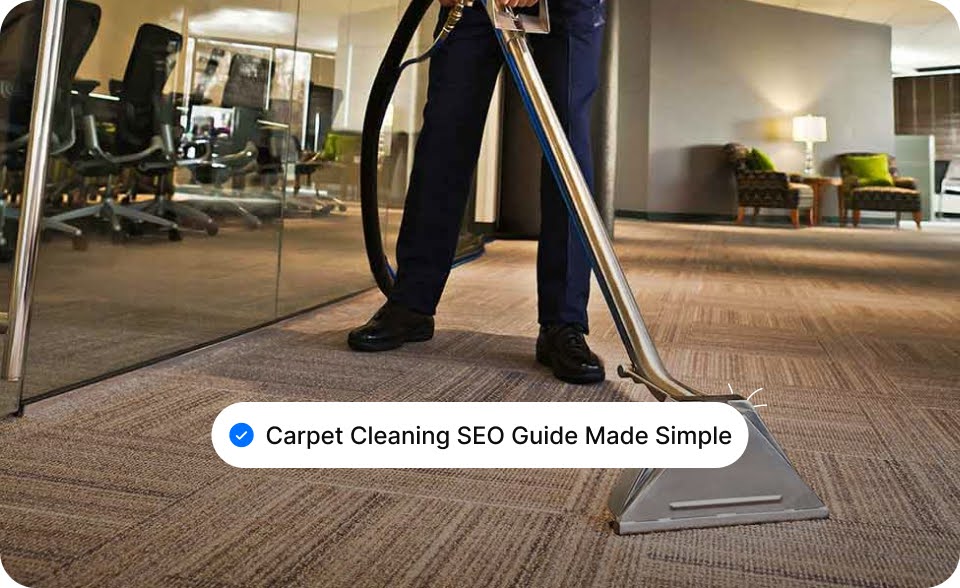
You could be the best carpet cleaner in your city, punctual, polite, and thorough, but if no one can find you online, your phone stays quiet. That’s the frustrating part: your quality isn’t the problem. Visibility is.
Today, people don’t ask neighbors first; they ask Google. And if your business doesn’t show up there, someone else gets the job, usually a company that’s not even half as good as you.
Carpet cleaning SEO ensures your business shows up when someone nearby searches for what you do best. It helps your name, your reviews, and your work get seen by the right people at the right time.
In this blog, we’ll walk through what carpet cleaning SEO really is, what a proper setup looks like, and how you can use simple steps to get found, trusted, and booked more often.
Carpet cleaning SEO is the process of helping your carpet cleaning business show up in local search results when people nearby look for services.
In plain terms, it’s how you make sure potential customers find your business first when they’re ready to book a cleaning.
When someone searches for a local carpet cleaner, Google checks a few things before showing results:
Your SEO efforts strengthen these signals. Most homeowners start their search online before calling a carpet cleaner. They want someone nearby, available soon, and trustworthy.
Understanding how SEO works is one thing, but seeing it in action is where the picture gets clear.
Here’s what makes an effective setup and how to get each part right:
If SEO had a front door, this would be it. Your Google Business Profile is what most people see first, even before your website. It’s your online business card, review hub, and map pin all in one.
What to do:
Your website should be built for humans first and then for Google. For that, your website needs to help people understand what you do and make it easy to call or book.
What to include:
SEO keywords should sound like something your customers would actually type. That’s how Google connects your pages to the right people.
Examples:
Use these naturally in your page titles, subheadings, and a few times in the text. Also, write short meta descriptions (the small text under your page title in search results) that tell people what you offer and where.
Behind every good website is a bit of clean, technical work that keeps it fast and smooth. It’s about making sure nothing gets in the way of a good user experience.
Here’s what to check:
The best marketing is proof. When people see your real work, they trust you. When they read your reviews, they believe you. When both live on your website, they choose you.
What to do:
If your name, address, or phone number (NAP) is inconsistent online, Google gets confused, and so do customers. A clean online footprint helps you appear trustworthy.
What to do:
Bonus: when local partners (like realtors, cleaners, or landlords) mention your business online, those mentions help your SEO grow faster and improve your visibility across your service area.
SEO becomes much easier to understand when you break it into three parts. Each one helps your carpet cleaning business get found and trusted in a different way:
The next step is turning that visibility into something measurable, such as calls, bookings, and long-term customers. That’s where strategy comes in.
Once your website, service pages, and Google Business Profile are set up, the next step is to turn those tools into steady jobs. A good carpet cleaning SEO strategy helps you move beyond just being visible. It helps you attract better customers, get more calls, and build trust that lasts.
Here’s how to do that:
1. Track Which Calls Turn Into Real Jobs: Keep a small log of where each call comes from and whether it becomes a paying job. Over time, you’ll see which sources bring real customers and which ones don’t. This helps you focus on what’s actually working instead of guessing.
2. Test Small Changes on Your Website: Try changing a headline or button text and see if more people call. Simple tweaks like “Same-Day Cleaning” or “Get a Quick Quote” often boost results without needing more traffic.
3. Share Pricing and Availability Clearly: Most people hesitate because they don’t know the cost or timing. Add lines like “Starts at $79 per room” or “Same-day slots available before 11 AM.” Clear info makes calling easier and builds trust.
4. Automate Review and Referral Requests: Set up automatic texts or emails after each job. Ask for a review, then follow up with a small referral offer. This keeps new reviews and word-of-mouth leads coming in without extra effort.
5. Improve How Calls Are Answered: Listen to a few recorded calls (with notice). You’ll hear what customers worry about. Create a short script that covers price range, timing, and next steps. Confident answers lead to more bookings.
6. Offer Simple Maintenance Plans: Give customers the option to book yearly or twice-a-year cleanings at a small discount. It keeps business consistent and increases repeat work, which helps both revenue and SEO.
7. Add the Right Schema Tags: Ask your web person to install a few small codes like AggregateRating, Offer, and ImageObject. They don’t change your site visually, but they help Google understand your business better.
8. Get Mentioned Locally: Share small updates or stories with local community pages, neighborhood groups, or business partners. These mentions are strong local SEO signals and help you stay top-of-mind in your area.
9. Focus on High-Value Neighborhoods: Some areas bring better jobs. Test small ZIP-code-based promotions or posts, then create short pages for the neighborhoods that bring the best work.
10. Review Your Numbers Monthly: Check three things: calls from Google, booked jobs, and top-visited service pages. If something drops, adjust the photo, headline, or pricing. Small, steady improvements add up over time.
Check those numbers once a month. If one page or area drops, don’t panic. Tweak a photo, headline, or price. SEO is about small, steady changes that add up over time.
Mastering SEO for your carpet cleaning business is not a one-time task but an ongoing process. By optimizing your website, creating valuable content, and building your local presence, you’re setting your business up for long-term success.
Remember, the goal is to make sure your potential customers find you when they need you the most. With the right SEO strategies in place, you can turn search engine traffic into loyal clients who keep coming back.
So, take the steps today to elevate your business’s visibility, and watch your leads, and your reputation, grow. The right SEO approach is your key to staying ahead of the competition. Let’s get started!
SEO helps your business appear organically in search results without paying for each click, while Google Ads are paid listings that show up instantly but disappear once your budget runs out. With SEO, you build long-term visibility; with Ads, you get quick visibility that stops when you stop spending. A healthy business often uses both together.
Photos and short cleaning videos show Google (and customers) that your business is active and real. Uploading before-and-after pictures, job-site clips, or customer testimonials regularly helps your profile stay fresh and can boost your visibility in local searches. It also helps people trust you faster than words alone.
Yes, but do it carefully. Being listed on trusted platforms like Yelp, Angi, Thumbtack, Facebook, and local directories gives Google more proof that your business exists. Just make sure your name, address, and phone number (NAP) match exactly across all sites. Inconsistent listings confuse search engines and hurt your ranking.
You can handle the basics yourself like claiming your Google Business Profile, adding keywords, and collecting reviews. But if you want faster, more consistent results (especially across multiple service areas), hiring an SEO professional can help with technical fixes, content planning, and tracking progress properly.
Indirectly, yes. Social media posts, especially those tagged with your city or showcasing your work, create extra signals for Google that your business is active and locally relevant. They also drive visitors to your site, which helps improve engagement metrics that search engines consider when ranking local businesses.

Most buyers start their journey online. They search for models, compare prices, check inventory, and read reviews, often from their phones. For dealerships, that means being findable in the exact moments buyers are looking, and making each vehicle listing clear, useful, and trust-worthy.
SEO for the automotive industry is a marketing effort that makes your inventory, service pages, and dealership visible and impactful across search and map results. It’s the mix of local visibility, structured inventory data, strong on-page content, and technical hygiene that turns searches into showroom visits and phone calls.
In this blog, you’ll get hands-on steps for dealership SEO: what matters, how to structure it and the everyday checks that keep your leads steady and qualified.
SEO for automotive industry means optimizing everything a buyer might encounter online: your website, vehicle listings, Google Business Profile, and third-party inventory channels. This is important, so that people searching for vehicles, parts, or services find your dealership and trust your offer.
For dealers, this breaks down into three practical goals:
Most buyers start on Google. They search for known keywords like “used Honda Civic near me” or “best truck deals in Dallas,” and expect to see real vehicles, with real prices, from nearby dealerships. That’s exactly what modern automotive SEO supports.
Here’s what makes it especially important today:
Google’s vehicle ads and inventory listings let shoppers see your cars, make, model, price, mileage, right inside search results. But this only works if your inventory feed is accurate and up to date. The cleaner your data, the more often your vehicles appear in those high-intent searches.
Adding “Vehicle schema” (a small code that labels your vehicle details for Google) helps search engines read your listings properly. That means your vehicles can show up with richer info, like price, availability, and photos.
Your Google Business Profile and local landing pages are what push your dealership into the map section of results. That’s where buyers click for directions, reviews, and calls. A strong local presence means you’re visible to people already ready to test-drive or buy.
These three realities make dealership SEO measurable.
With the right SEO strategies, your dealership can show up where serious buyers are searching and convert clicks into customers. These proven approaches focus on visibility, trust, and consistent lead flow:
Local SEO is what puts your phone number, address, and reviews right in front of people ready to visit today. It turns nearby searchers into actual foot traffic.
If you sell cars in Austin, there’s no point showing up in Dallas searches. That’s why local SEO is the backbone of dealership marketing.
What to focus on:
Pro Tip: Keep your GBP updated monthly. Fresh photos, regular posts, and recent reviews signal to Google that your dealership is active and trustworthy.
Most dealership websites are cluttered: too many buttons, pop-ups, or generic “inventory” pages that all look the same. On-page SEO fixes that.
Key areas to improve:
Pro Tip: Your Vehicle Description Pages (VDPs) should behave like product pages: include keywords, specs, price, mileage, photos, and an easy “Book Test Drive” button.
If your website loads slowly, people leave. It’s that simple. Technical SEO ensures your site runs smoothly behind the scenes; no broken links, confusing URLs, or delays that make buyers hit “back.”
Key areas to check:
Pro Tip: Even small improvements to speed and mobile usability can increase leads. Fast-loading pages = happier buyers and better SEO.
You don’t need 100 blog posts to succeed. You just need useful content that answers buyer questions. When your content helps people with buying tips, maintenance guides, or financing advice, they remember your dealership as the one that actually knows what it’s talking about.
Focus on:
What matters most:
Pro Tip: Each content piece should solve a real buyer question. That’s what makes readers trust you enough to visit or call.
Google pays attention to what others say about your dealership too. That’s what off-page SEO is about: links, mentions, and reviews from other trusted sources that confirm you’re a real, reliable business.
How to build it:
Pro Tip: Quality beats quantity. One local news mention or manufacturer link is worth more than 20 random directory links.
SEO only works when it’s measurable. Your numbers are your feedback loop.
Set up:
Pro Tip: Review analytics monthly. Focus on trends like “which pages get calls” and “where visitors drop off.” Those insights guide your next round of SEO improvements.
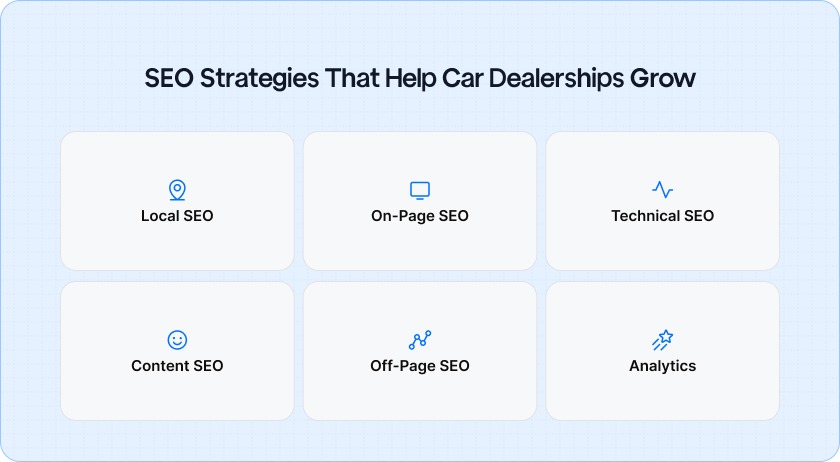
These pieces work together like a sales funnel: visibility → trust → visits → leads.
When your website, listings, and local search results work together, you earn trust before the buyer even arrives. Small, steady improvements to these details create big shifts in how often buyers find and choose you.
If your dealership is serious about growth, your SEO should work as hard as your sales team. Optimize it once, maintain it consistently, and let it keep doing what it’s built for, bringing the right people straight to your lot.
Automotive SEO focuses on dealership-specific elements like vehicle detail pages (VDPs), inventory feeds, and local service areas. It’s more structured than general SEO because it involves live data like prices, mileage, and vehicle availability.
You’ll typically see early visibility improvements in 60–90 days, but stronger organic leads build over 4–6 months. The more consistent your updates and data accuracy, the faster results compound.
Yes, SEO complements your paid campaigns. PPC brings instant traffic, while SEO builds long-term trust and visibility that continues even when ads are paused. Together, they improve lead quality and reduce cost-per-acquisition over time.
At least once a month. Add new vehicles, post local updates, refresh your photos, and update pricing or hours. Regular updates signal activity to Google, helping maintain and improve rankings.
Neglecting their Google Business Profile or letting duplicate inventory pages confuse search engines. Keeping your GBP active and your site clean, fast, and consistent will outperform heavy ad spend in the long run.

You might be providing reliable, honest plumbing work every day, yet the phone still isn’t ringing as often as it should. It’s not usually a problem with your service. It’s that people in your area aren’t finding you when they’re searching online for help.
When someone has a leak, a broken water heater, or a sudden plumbing issue, they search quickly for the first trusted business they can contact. If your business doesn’t show up in those local search results, the job goes to someone else before you even have a chance to talk to them. That gap between your quality of work and your online appearance can directly affect your bookings.
This guide focuses on closing that gap. We’ll walk through practical SEO steps that help your plumbing business show up locally, build trust faster, and make it simple for homeowners to reach you when they need help right away.
When we talk about plumbing leads, we’re referring to people or businesses who have expressed interest in plumbing services and could become paying customers. These leads are potential clients who require drain cleaning, pipe repair, water heater installation, or any other plumbing service and are actively seeking someone to hire.
Here’s what defines good plumbing leads:
By clearly understanding what plumbing leads are and what makes them good, you can refine your marketing efforts, tailor your messaging, and build systems that bring in leads that convert into real work.
When considering plumbing leads, it’s crucial to recognize what qualifies as a genuine opportunity for your business.
Generating high‑quality plumbing leads in 2025 means combining smart, modern tactics with consistent, well‑executed effort. Below are proven strategies that plumbers can rely on to attract customers and convert interest into jobs.
Your website is your first impression. It should be built to earn trust quickly and convert visitors into calls, quote requests, or bookings.
When to use it:
When you already receive traffic (website visits, Google Business Profile views) but the number of calls or appointment bookings is low. Or when you’re launching/re-launching a site and want it to serve as your lead-generation engine.
Actionable tips:
Benefits:
A high-performing website acts as your silent salesperson. It boosts credibility, increases conversion rates from visitor to lead, and reinforces your professionalism.
Point is: good website = good first impression = more leads.
For landscapers, Google’s “local pack” (map results) is prime real estate. Most people search and rarely scroll past those top listings.
When to use it:
When you serve a defined service zone (city, county, suburbs) and you want your business to show up in local search results (Google Maps, “near me” queries) for each area you cover.
Actionable tips:
Benefits:
Proper local SEO helps you show up when someone nearby searches for what you do. It puts you in the “map pack” and local results — the prime real estate for service-business searches.
You become visible to people already looking for a landscaper in your region, which means higher chance of booking.
Paid ads are the quickest way to reach clients who need landscaping now. They complement SEO by filling in gaps while organic rankings grow.
When to use it:
When you want faster results than organic SEO alone can deliver, or when you’re entering new service areas and want to dominate quickly. Also useful during peak seasons (e.g., spring/summer for landscaping) when demand is high.
Actionable tips:
Benefits:
Paid campaigns let you compete for leads now, not just later. When done smartly, this means you can funnel high-intent prospects into booked jobs more quickly, providing a more predictable flow of work.
People don’t hire landscapers they don’t trust. Positive reviews, visible testimonials, and community engagement are your strongest conversion assets.
When to use it:
When you’ve already completed jobs and have a satisfied client base. Also when you're operating in a competitive area and need to stand out.
Actionable tips:
Benefits:
Trust is everything in trades like landscaping. High review counts and positive ratings improve your perceived reliability and directly impact your ability to convert browsers into customers. Also, word-of-mouth (via referrals) typically brings warmer leads with higher conversion rates and lower acquisition costs.
Homeowners research before they hire, meaning educational content and consistent local visibility keep your brand top-of-mind long before a client reaches out.
When to use it:
When you want to nurture potential clients who aren’t ready to book yet (e.g., they’re comparing landscapers), or you want to build your brand so you show up consistently in your market.
Actionable tips:
Benefits:
Good content put you front-of-mind, even before someone actively searches. Over time, it builds familiarity, authority and trust. That means when a homeowner does look for a landscaper, you’re already a known option.
Micro-moments are high-intent searches like emergencies.
When to use it:
When people need a landscaper quickly. For example, prepping for an event, urgent lawn restoration after damage, or seasonal clean-up. These are “right-now” moments rather than long research journeys.
Actionable tips:
Benefits:
In these moments, prospects are ready to act. If you capture that urgency, with a clear CTA and visibility in their search, you beat competitors who are slower or harder to reach. This often leads to higher-value jobs and less price negotiation.
As Google’s AI and voice search evolve, structured data and FAQ-style content help your business appear in snippets and smart assistant answers.
When to use it:
When you’re ready to move beyond basic SEO and compete for high-visibility placements (snippets, voice search results, local 3-pack). Especially valuable if you’re in a saturated market.
Actionable tips:
Benefits:
By aligning with the way search engines and voice assistants pull data, you increase the chance of being featured in “quick answer” boxes or voice search results. That gives you a visibility boost and differentiates you from competitors who only do standard SEO.
Leads lose value by the minute. If you respond fast, you’re almost always the one they book.
When to use it:
When you’re receiving inquiries (calls or forms) but conversion to booked jobs remains low or slow. Especially relevant if you serve emergency or time-sensitive jobs.
Actionable tips:
Benefits:
Faster response increases trust and prevents prospects from choosing the competitor who called them first. Data shows phone leads convert faster and retain longer in the home services sector.
In the end, speed and clarity in response mean better conversion to booked jobs.
Most visitors don’t convert on their first visit. Remarketing helps bring them back, while recurring contracts stabilize your pipeline.
When to use it:
When a visitor came to your site but didn’t book, or when you serve clients who require ongoing services (maintenance, seasonal landscaping, commercial grounds). This is about staying visible and capturing larger opportunities.
Actionable tips:
Benefits:
Remarketing gives you a second chance to convert someone who showed intent but didn’t act immediately. Recurring contracts give you stability in workload and income.
Together, they improve the long-term value of your marketing efforts beyond one-off jobs.
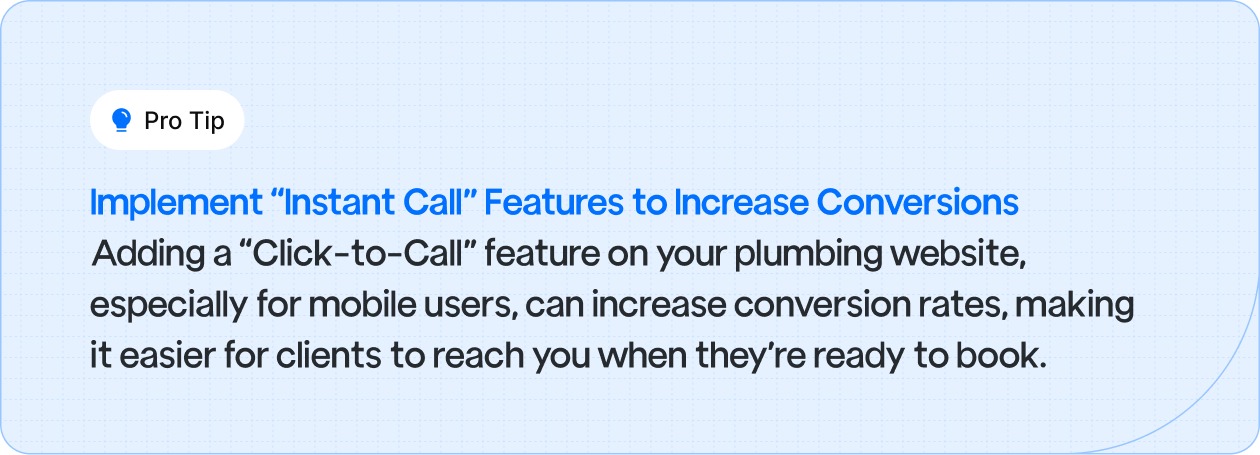
Tracking shows what actually drives profitable jobs.
When to use it:
When you’re investing in several channels (organic SEO, paid ads, social media) and want to identify which are delivering truly valuable leads.
Actionable tips:
Benefits:
Data-driven optimisation means you don’t throw money at every channel and hope. You focus on what works. Over time, this reduces your cost per booked job, increases efficiency, and improves profitability of your marketing.
When you’re looking to attract plumbing leads, it’s important to recognise that not all leads are the same.
Let’s break down the main types of leads you’re likely to encounter:
These are plumbing leads from homeowners who have an urgent issue: burst pipes, major leaks, non‑working water heaters, sewer backups. They’re ready to hire immediately.
These plumbing leads come from homeowners needing a fix or tuning up of their plumbing system, not necessarily an emergency, but soon. Examples: clogged drains, dripping faucets, annual inspections.
Good marketing for these leads includes content showing you handle common problems, and offers of maintenance plans or inspections.
These plumbing leads come from homeowners or property managers looking to add or upgrade plumbing systems: new bathrooms, kitchen remodels, pipe upgrades, smart plumbing installations.
These jobs often have higher ticket values and longer decision‑making cycles. To attract these leads, you’ll want to show project galleries, case studies, service pages for remodeling work, and strong trust signals.
These plumbing leads originate from businesses, multi‑unit properties, or commercial buildings rather than individual homeowners. Their needs might include large‑scale plumbing installation, ongoing contract maintenance, or urgent commercial plumbing issues.
Beyond service need, plumbing leads also differ in how they’re acquired and shared: shared leads, exclusive leads, subscription lead‑services.
Understanding which type of leads you want (and can afford) is part of your lead generation strategy.
By recognising the variety of plumbing leads, emergency, repair/maintenance, installation, commercial, and lead‑delivery types, you can:
Attracting more plumbing leads isn’t just about being present; it’s about being found at the right time, in the right place. By applying the right strategies, you're setting your business up for sustainable growth and more clients.
It’s important to stay proactive and consistent with your approach to lead generation, but you don’t have to do it alone.
At Gushwork, we design to simplify the process of managing and growing your online presence, ensuring you stay visible to those who need your services. With the right strategy and support, you can drive more leads, build trust, and take your plumbing business to the next level. Let us help you get there!
1. How can I convert plumbing leads that are just browsing or researching?
To convert leads that are in the research phase, provide valuable content like blog posts, how-to guides, or free consultations. Offering educational resources can build trust and position your business as the go-to expert when they're ready to hire.
2. What is the most cost-effective way to generate plumbing leads for a small business?
Start by focusing on organic growth strategies like local SEO and word-of-mouth referrals. You can also engage with community groups on social media to create brand awareness. Paid ads work, but organic methods offer long-term sustainability with a lower upfront cost.
3. What kind of follow-up system works best for plumbing leads?
Implement a multi-step follow-up process, starting with an immediate acknowledgment of their inquiry. A combination of automated emails and personal phone calls ensures that the lead feels valued while providing timely responses to keep them engaged.
4. How can plumbing businesses target high-ticket leads for major installations?
For larger projects like installations and upgrades, focus on showcasing your expertise through detailed case studies, high-quality visuals, and customer testimonials. Marketing strategies should emphasize quality and reliability, along with offering free quotes or consultations to initiate contact.

A lot of landscaping businesses aren’t struggling because of the quality of their work. The real issue is that people nearby simply aren’t finding them when they search online. Someone in your area may be looking for lawn care or planning a new outdoor space right now, but if your business doesn’t show up, that opportunity passes quietly.
You feel that when the phone doesn’t ring as often as it should. Competitors get the first look simply because they appear higher in search results, not because they do better work. That can be frustrating, especially when you know you could give that customer a better experience.
This guide focuses on fixing that visibility problem. We’ll walk through straightforward SEO steps that help your landscaping business show up in local searches, build trust faster, and make it easier for people to contact you when they’re ready to move forward.
Today’s homeowners are increasingly turning to their phones and computers to find reliable, local services. Knowing how they search and what they look for can help you optimize your online presence and attract the right clients:
A large share of searches include “near me.” Phrases like “landscaping services near me” or “lawn care near me” show just how local this industry is. Google uses location data to rank nearby businesses higher, which means an optimized Google Business Profile and strong local SEO can directly improve visibility.
Many homeowners also search for specific services based on their exact needs—tree trimming, garden design, irrigation, or hardscaping. Queries like “garden design in [city]” or “tree removal near me” reveal intent. To show up for these, your website should feature dedicated service pages that clearly describe what you offer and where you operate.
More homeowners are using voice search, asking Google questions like, "When should I schedule lawn care?" These queries are more conversational and show that homeowners are looking for direct answers.
Many homeowners will rely on reviews to guide their decisions. They search for services like "best landscaping company in Albany" or “top-rated lawn care services near me” to find companies with good reputations.

Some homeowners also turn to platforms like Instagram, Pinterest, or Facebook to find landscaping ideas or professionals. They might search for “landscaping ideas” or “backyard design inspiration,” and from there, they find businesses offering those services.
But how does Google decide which landscaping companies appear at the top? Let’s take a look at the local ranking factors that impact how your business gets ranked.
For landscapers who serve local clients, this means focusing on the ranking factors that matter most in your area. According to Google, the primary local ranking factors boil down to relevance, distance, and prominence.
Here’s how these apply specifically to landscaping businesses and what you should focus on.
Google prioritizes businesses that clearly match what users are looking for.
To boost relevance:
Local search results favor businesses closest to the searcher’s location.
To strengthen this signal:
Prominence reflects how well-known and reputable your business is both online and offline.
To grow your prominence:
Google also rewards websites that are technically sound and optimized for local SEO.
Focus on:
Google measures how people engage with your business online. Things like clicks, calls, and how long they stay on your page.
Improve engagement by:
By focusing on these ranking factors, relevance, distance, prominence, technical health, and user engagement, you increase your chance of ranking well for “seo for landscapers” in your local market. The goal isn’t just to appear, but to appear credibly, near enough, and ready to serve.
Boosting your visibility online as a landscaping business is about applying a smart SEO strategy that targets the right audience in the right place. Here’s a tailored set of actionable SEO tactics for landscapers, based on proven approaches but rewritten in a fresh, practical way.
To show up in local searches, you must know exactly what your potential clients are typing into Google.
Your website must clearly reflect what services you offer and where. This helps both search engines and clients find and trust you.
Your Google Business Profile is like a digital storefront for local clients.
Appearing local and trusted in your service area helps search engines recognize your relevancy, and, more importantly, helps local clients find you.

Quality content establishes your authority, builds trust with clients and search engines, and gives you more opportunities to rank.
SEO is an ongoing process. Monitoring your progress allows you to invest time where it matters.
Using these strategies consistently will position your landscaping business to show up where it matters, when local homeowners are actively searching. Focus on being visible, trusted, and memorable, and you’ll turn more clicks into calls and jobs.
Your landscaping business does great work, now it’s time to make sure it’s seen by the right people at the right time. SEO is the bridge between your service and the homeowner who’s already searching. When you focus on proven tactics, you're not just showing up; you’re standing out.
The market is already turning to search engines, and your competitors are making their move. Are you ready to step up and claim your place at the top of local search results? Let SEO drive the traffic, and watch those clicks turn into clients.
The opportunity is here, let’s get started.
To measure SEO success, track key metrics using tools like Google Analytics and Google Search Console. Look for improvements in organic traffic, keyword rankings, and lead conversions. Also, monitor click-through rates from local search results and calls or requests for quotes via your site.
Yes! SEO works for businesses of all sizes. By focusing on hyper-local SEO, you can rank for specific neighborhoods or towns and ensure you're visible to those who need your services in your immediate area.
After completing a job, politely ask satisfied clients to leave a review on your Google Business Profile. Provide them with a direct link to make the process easy, and always respond to reviews to show engagement and build trust.
Mobile optimization is critical. Many homeowners search for landscapers on their phones, so a mobile-friendly, fast-loading website improves user experience, reduces bounce rates, and boosts your local SEO rankings.
Yes, you can target multiple locations by creating location-specific landing pages. Focus on unique, local content for each city or neighborhood you serve, and ensure your business details (NAP) are consistent across all listings.

In the construction business, standing out is all about how you connect with your audience. Content marketing for construction helps build trust, showcase your expertise, and address the specific needs of potential clients.
By sharing project successes and offering valuable insights, you can transform a casual visitor into a loyal customer, building long-term business growth.
This blog will explore the essential strategies that construction companies can use to harness the power of content marketing, build trust, and drive long-term success.
Content marketing allows your business to stand out by becoming a resource, educating your potential clients and addressing their concerns before they even reach out. It’s a way to showcase your expertise, demonstrate value, and build trust.
Here’s why content marketing is crucial for construction companies:
By addressing their pain points, like dealing with regulations or understanding building processes, you create content that resonates with your ideal audience, driving quality leads who are more likely to convert into clients.
When you educate your audience about construction-related topics, you demonstrate your knowledge and ability to tackle their challenges.
A great strategy should capture the attention of potential clients, nurture relationships, and ultimately drive them to choose your services. Here’s how to craft a content strategy that engages and converts.
Understanding who you’re speaking to is the first step in building a content strategy that works. Every client type, including homeowners, property developers, architects, and project managers, has unique needs and interests.
Understanding these nuances helps you create content that addresses their pain points.
Tools like surveys, online forums, or even simple client interviews can reveal valuable information. This data allows you to craft content that truly addresses their needs.
Identifying these concerns will help you create content that feels relevant and valuable to them.
Well-defined goals keep your content marketing efforts focused and measurable; without them, it's easy to lose direction.
Your goals should align with your business objectives to ensure that every piece of content contributes to your overall success.
By monitoring KPIs, you'll know what's working and what needs improvement.
Quality content is the heart of any marketing strategy. It’s about delivering value that informs and engages your audience.
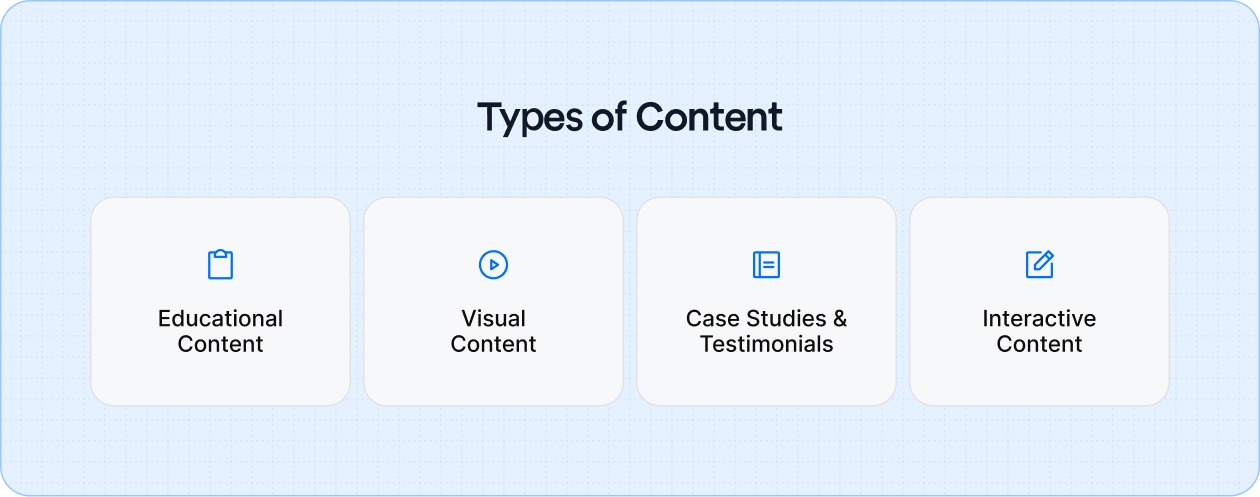
SEO is the backbone of content visibility. Without it, even the best content might go unnoticed.
Creating great content is only half the battle; getting it in front of the right people is equally important.
Engage with your audience through comments and messages to build relationships and encourage trust.
Tracking your content’s performance is essential for understanding what works and where improvements can be made.
Changing your content format, adjusting SEO tactics, or experimenting with new distribution channels, refinement is an ongoing process.
One of the most effective ways to build trust and demonstrate your expertise is through client testimonials and success stories.
These real-world examples offer potential clients tangible proof of your capabilities and build your reputation as a reliable, results-driven construction company.
Written testimonials can be complemented by video testimonials to provide an even more personal touch.
These success stories position your company as a trusted partner, capable of delivering high-quality results.
Partnering with experts and influencers in the construction industry can significantly extend the reach of your content.
Collaborations can bring new perspectives to your content and help you tap into new audiences, establishing your company as a leader within your field.
These experts add authority and offer additional insights that resonate with your target audience.
These collaborations can drive more qualified traffic to your website, positioning your company as a leader in your sector.
Content marketing is a powerful tool that enables construction companies to build trust, engage potential clients, and showcase their expertise.
By understanding your audience, setting clear goals, and consistently creating valuable content, you can drive meaningful business growth.
These strategies help you attract leads and establish lasting relationships with clients that lead to sustained success.
A1. Content marketing for construction companies involves creating valuable, relevant content to engage and educate potential clients. It helps businesses build trust, improve SEO rankings, and convert leads into customers by addressing the specific needs of their audience.
A2. By providing informative and educational content, construction companies can attract leads who are actively seeking solutions. Content such as blog posts, case studies, and how-to guides can help potential clients find answers to their questions and establish trust in your expertise.
A3. The best content types for construction businesses include blog posts, case studies, videos, and project showcases. These formats help demonstrate expertise, engage the audience, and build credibility, especially when paired with visual content like before-and-after photos or time-lapse videos.
A4. Construction companies use SEO in content marketing by optimizing their content with relevant keywords, improving website structure, and creating high-quality blog posts and resources. This helps increase their visibility on search engines and drives organic traffic from potential clients.
A5. Success can be measured using KPIs such as website traffic, engagement metrics (like social shares and comments), lead conversion rates, and SEO rankings. Tools like Google Analytics and social media insights help track these metrics, guiding content refinement for better results.
A6. Yes, even small construction businesses can greatly benefit from content marketing. By targeting specific client needs and focusing on local SEO, they can build a strong online presence, increase brand visibility, and attract quality leads without needing a large marketing budget.
A7. The frequency of content publishing depends on the company’s resources and goals. For consistent engagement, posting new content weekly or bi-weekly is ideal. However, it's more important to focus on quality and relevance rather than quantity to ensure content resonates with your target audience.

When people need a contractor, they turn to search engines to find reliable services nearby. If your business isn’t visible in local search results, potential clients may look elsewhere.
By optimizing your online presence, you can increase visibility and connect with customers exactly where it matters most: locally. This guide will walk you through the essential steps to help your business stand out and attract more local clients.
Local SEO is about optimizing your online presence so your contracting business shows up when people in your area search for services you offer. It’s about making sure potential clients in your immediate service area can find you when they need help the most.
When homeowners search for contractors, they want someone local. If your business is optimized for local SEO, it increases your chances of appearing in those vital “near me” searches and local map results, bringing clients right to your door.
Here’s why local SEO matters for contractors:
Without local SEO, your business is invisible to many potential clients who are actively searching for services right in your area. But local SEO is an ongoing process that requires regular attention to things like your Google Business Profile, client reviews, local backlinks, and much more.
This is where expert guidance can really make a difference. With the right strategy, you can rise above the competition and dominate local search results.
Must Read: Get Noticed or Get Overlooked: The Complete Guide to SEO for Contractors
When it comes to local SEO for contractors, the goal is to be found by clients in your area who are actively searching for your services. Achieving that requires a deep understanding of how search engines work and how to align your online presence with what local clients need.
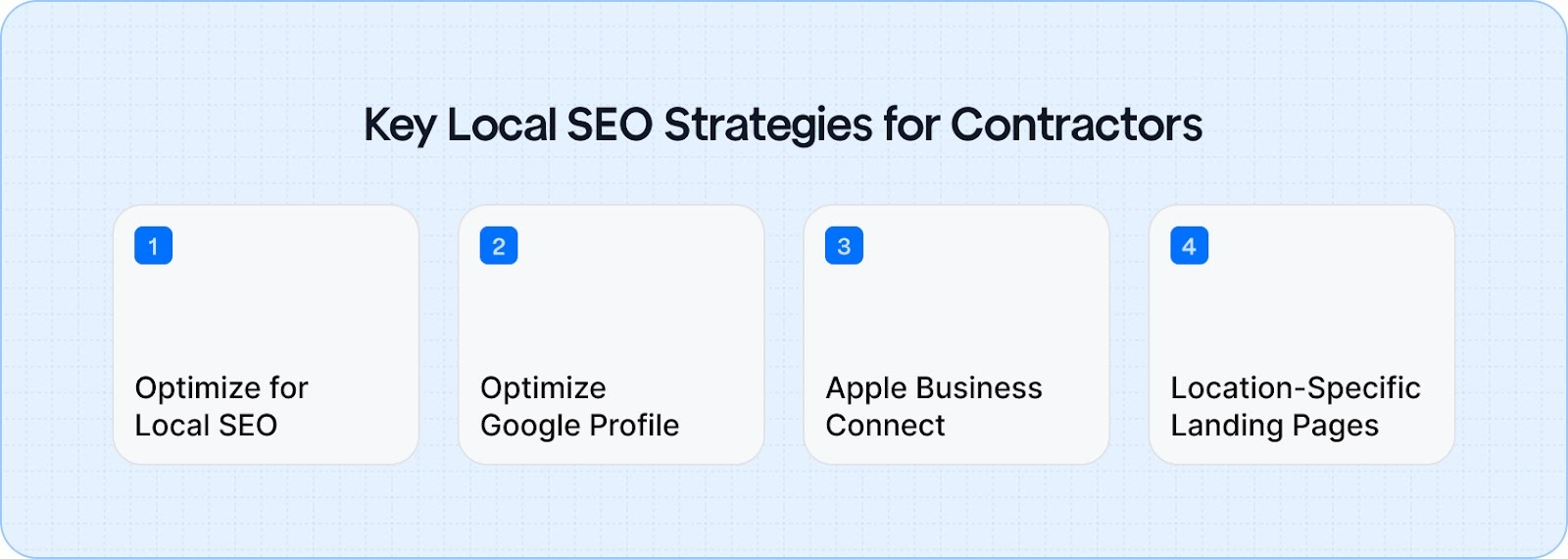
Here's how to ensure your contracting business is visible and easily found in your service area.
Your website is the foundation of your local search optimization strategy, and it needs to be built to cater to both search engines and potential clients. This means focusing on the user experience.
Make sure the flow of the website guides potential clients straight to the next step, such as reaching out or requesting a quote, from case studies, contact information, or service details.
Choosing the right local keywords involves careful research and an understanding of how to integrate these terms naturally into your content.
But this approach requires more than just listing cities or neighborhoods; it requires optimizing each page to truly reflect local interests, language, and needs.
Your Google Business Profile (GBP) is often the first impression potential clients will have of your business online. It requires ongoing attention and optimization to stay relevant and competitive.
An outdated profile can also lead to missed opportunities as clients look for businesses that actively showcase their work and engagement.
This ongoing process requires consistent attention and strategy to be effective.
Apple Business Connect must be part of your local SEO strategy. As more people turn to Apple Maps and Siri to search for local services, you must ensure your business is visible on Apple Search and Apple Maps.
Location-specific landing pages are one of the most effective ways to target local searches and gain visibility in the areas you serve.
Each page should be optimized for the city or neighborhood you serve, ensuring you appear in local searches on both Google and Apple Maps.
It also makes it easier for clients to find exactly what they’re looking for when they search for services in their specific location.
How to Optimize: Simply listing the location isn’t enough. Each page should include local landmarks, neighborhood-specific content, and, when possible, client testimonials or case studies from that area. This helps establish relevance and trust while making it clear that you are a genuine, active player in that locality.
To stand out in a competitive local market, contractors must build authority and trust with both Google and potential clients. Here’s how to strengthen your online presence and establish yourself as the go-to service provider in your area.
Google reviews have long been a significant part of local SEO, but reviews on Apple Business Connect are equally important. Positive reviews on Apple Maps can help improve your visibility, especially as many people use Apple devices to search for local services.
Citations are mentions of your business name, address, and phone number (NAP), on other websites, such as local directories or industry-specific platforms. Consistent citations help Google understand your business’s location and relevance, improving your rankings in local search results.
How to Manage Citations:
Backlinks are one of the strongest signals that tell Google your contracting business is trustworthy and relevant.
Local SEO is about local relevance. A few high-quality backlinks from credible local sources can make a bigger difference than dozens of generic ones.
Local Partnerships for Backlinks
Strong relationships can translate into strong rankings. Collaborate with:
These connections strengthen your SEO and reinforce your reputation as a trusted local professional.
Local Directories and Industry Sites
Make sure your business is listed in credible local directories and industry-specific platforms such as:
Each listing improves your visibility and sends positive signals to Google about your business’s legitimacy and activity in the community.

Local SEO is key to helping your contracting business stand out in your area, but small mistakes can significantly impact your visibility.
Let’s dive into the most common local SEO mistakes contractors make, and how to avoid them to improve your rankings and online presence.
One of the simplest yet most impactful mistakes is inconsistent Name, Address, and Phone Number (NAP) across various platforms.
When your business details are mismatched, it confuses Google and harms your rankings in local searches. Here's what to keep in mind:
Maintaining accurate NAP information might sound easy, but ensuring consistency across multiple listings takes effort and organization.
With most local searches happening on mobile devices, a website that isn’t optimized for mobile can lose you valuable business.
Optimizing for mobile is a complex task that may require professional insight, as a properly optimized mobile site can be the difference between gaining a client and losing one.
One of the most important aspects of local search optimization is tracking how your efforts are performing. Without proper tracking, you won't know if your strategy is working or if there are areas that need improvement.
Without tracking and adjusting based on performance, you might miss valuable insights that could improve your local SEO results.
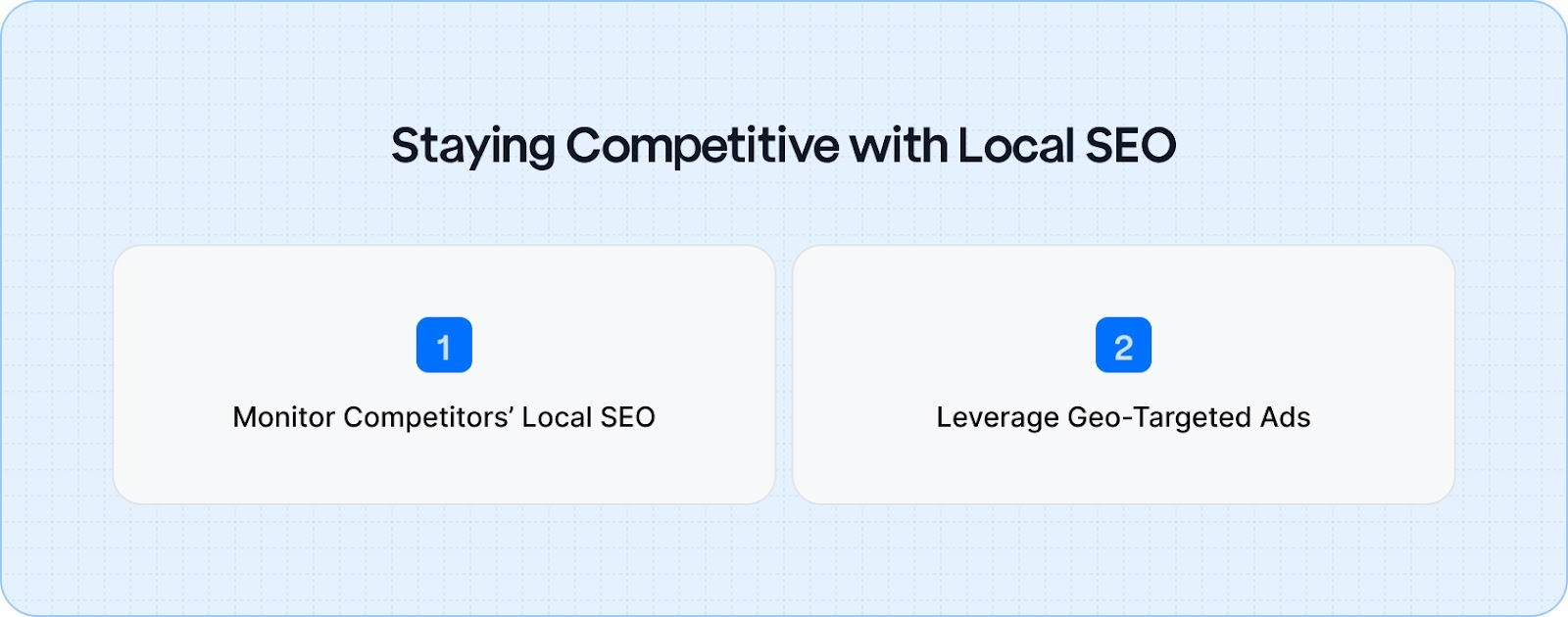
In a crowded market, maintaining strong local SEO ensures your business remains visible to potential clients. By tracking competitor strategies and using targeted ads, you can stay ahead and attract more local leads.
To stay informed, track how your competitors are performing in local searches. Tools like SEMrush allow you to monitor local keyword rankings and identify areas where your competitors are succeeding.
This helps you find gaps in your own strategy and refine your approach to improve visibility.
In addition to optimizing your organic listings, consider running local ads through Google Ads and Apple Search Ads. These ads allow you to target users actively searching for services near them, ensuring your business is visible at the right moment.
Local SEO is a continuous effort that, when done right, can significantly improve your visibility and fill your pipeline with high-quality leads.
While the process may seem overwhelming at times, staying consistent and optimizing the right elements will set your business up for long-term success.
As a contractor, having the right SEO strategy is essential, but managing it all on your own can be challenging.
A1. To improve your local SEO, optimize your website with location-based keywords, create service area pages, claim and update your Google Business Profile and Apple Business Connect, gather reviews, maintain consistent NAP (Name, Address, Phone) information, and build local backlinks.
A2. Reviews help establish trust with both Google and potential clients. Positive reviews improve your local rankings, and responding to reviews shows that you value customer feedback, boosting your credibility and SEO performance.
A3. Use Google Analytics and Google Search Console to track your local SEO performance. These tools provide insights into your website's traffic, keyword rankings, and conversions, helping you understand what's working and what needs improvement.
A4. Service area pages are dedicated pages for each location or neighborhood you serve. These pages help Google associate your business with specific local searches, improving your visibility in those areas. Yes, they are essential for effective local SEO.
A5. You should update your Google Business Profile regularly, especially after completing major projects, adding new services, or offering promotions. Posting updates weekly and keeping your information current shows Google that your business is active and relevant.
A6. Local citations are mentions of your business’s name, address, and phone number on other websites, such as online directories. They help search engines verify your business information and improve local SEO rankings, so consistency across all platforms is crucial.
A7. Yes, paid ads like Google Ads or Local Services Ads can support your local SEO efforts. These ads target local searches, putting your business in front of potential clients who are actively looking for services in your area, driving immediate visibility and leads.

Connecting with customers at the right time can turn a simple interaction into a valuable opportunity.
In the automotive space, email marketing provides a direct, effective way to stay in touch with your audience, sharing timely offers, service reminders, and important updates that keep your business front and center.
This guide will walk you through building impactful email campaigns that truly resonate with your customers and deliver measurable results.
The path a customer takes, from considering a new vehicle to becoming a loyal owner, is complex and filled with moments that can shape their decision.
Understanding where a customer is in their journey and engaging with them accordingly can significantly impact sales and build long-term relationships.

The buyer journey breakdown:
Each stage of the journey offers a unique opportunity to connect with your customer. But managing it successfully requires a carefully crafted strategy that delivers the right content at the right time.
That’s why a thoughtful, expert approach to email marketing is essential to ensure your messages resonate and drive results.
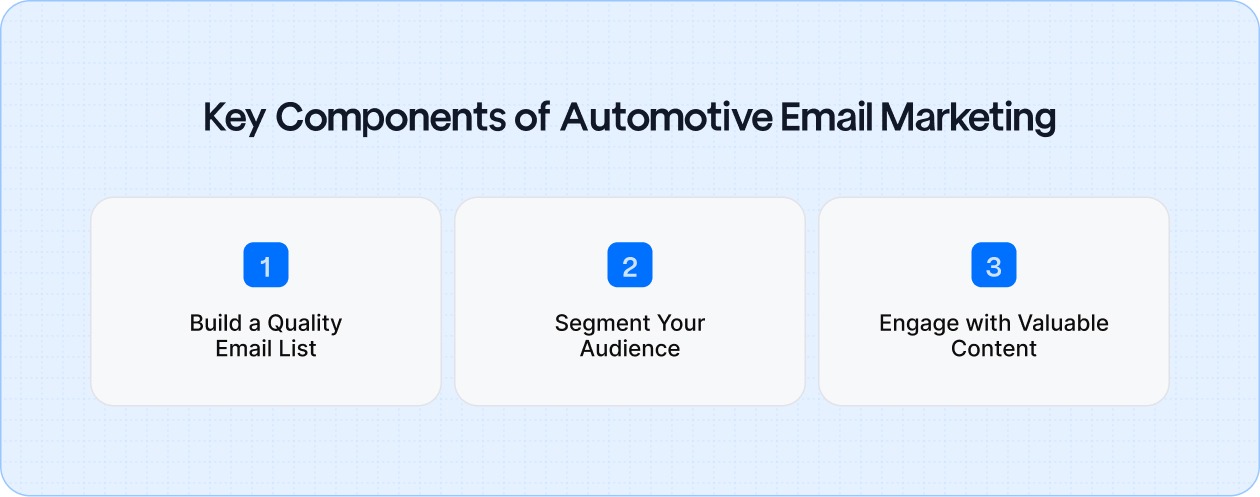
Building a successful automotive email marketing program starts with laying a solid foundation: a well-organized email list and a clear segmentation strategy. Without these, you’re simply sending messages into the void. Here’s how to get it right:
Successfully engaging automotive customers through email is about strategically reaching the right people with the right message at the right time.
Here’s how you can make your automotive email marketing program stand out:
Create sign-up forms that are personalized to specific vehicles, offers, or promotions. When a customer expresses interest in a particular car model, offer them a chance to sign up for exclusive deals or a test drive for that model.
Why It Works: Customers engage more when the content is directly relevant to their interests. By customizing your email offers, you capture qualified leads who are more likely to act on your messages.

Engage customers based on their interests and interactions with your brand. For example, if a customer has shown interest in a specific vehicle or service through a website visit or past email interaction, send them a follow-up email with a relevant offer or additional information.
Why It Works: Behavioral triggers allow you to send content that aligns with the customer's preferences and actions, making your emails more relevant and timely. This increases the likelihood of engagement and conversion, as customers receive offers that reflect their specific interests.
Set up automated email campaigns that engage customers throughout the ownership lifecycle, such as service reminders, maintenance tips, and even anniversary emails.
Why It Works: Automation keeps customers engaged even after they’ve made a purchase, ensuring they return for service appointments or consider upgrading.
These automated touchpoints help maintain a connection with customers, building long-term loyalty.

Instead of relying on browsing or service history, focus on asking customers directly about their preferences through surveys or sign-up forms. For example, let customers choose their favorite vehicle types, features, or upcoming promotions they’d like to hear about.
Why It Works: Emails that reflect customer interests feel more relevant and are more likely to engage recipients. This approach makes customers feel heard and valued, strengthening brand loyalty and increasing the chances of conversions.

Offer content that educates, like maintenance tips, vehicle care guides, or information on financing. The goal is to keep customers engaged even when they aren’t actively shopping for a car.
Why It Works: Value-first content builds trust with your audience, encouraging them to keep engaging with your emails even after they’ve made a purchase. It also positions your brand as a helpful, long-term resource.

Experiment with different subject lines, CTAs, and send times to see what resonates most with your audience. Test variables like emotional appeal versus practical offers to determine the best approach.
Why It Works: A/B testing helps you refine your strategy based on what your audience engages with most, leading to higher open rates and more conversions.

Regularly clean your email list by removing inactive subscribers and bounce-back emails. Implement a sunset policy for subscribers who haven’t opened or clicked emails in a certain period.
Why It Works: A clean list ensures your emails reach those who want to hear from you, improving deliverability and engagement rates. It also helps keep your campaigns more cost-effective.

Designing automotive emails that capture attention and drive engagement is about creating a seamless experience that encourages action. From layout to images, every design choice plays a role in how your audience interacts with your emails.
Here’s how to design emails that stand out in crowded inboxes:
With more people checking emails on mobile devices, a clean, simple design is a must. Use single-column layouts that are easy to read on smaller screens, and ensure that buttons and links are large enough to tap without frustration.
If your emails are hard to view on mobile, you risk losing valuable engagement.
Every email should have a clear call to action (CTA), such as scheduling a test drive, exploring financing options, or learning more about a vehicle. Make sure your CTAs are bold, easy to find, and stand out from the rest of the content.
A well-placed CTA will guide readers toward taking the next step in their buying journey.
Your emails should reflect your dealership’s or brand’s personality. Use your brand’s colors, fonts, and logo to ensure your emails are instantly recognizable.
Consistent branding helps build trust and reinforces your business identity, making it easier for customers to recognize and connect with your brand.
To truly elevate your email marketing efforts, it's essential to assess how your campaigns are impacting business goals.
By analyzing performance metrics, you can pinpoint what’s working, make informed adjustments, and continuously improve your strategy for better engagement and ROI.

To truly gauge the effectiveness of your email campaigns, it's important to track key performance indicators (KPIs). Focus on the following metrics to get a clear picture of your campaign's success:
By continuously measuring these metrics, you can identify trends and adjust your approach for even better results.
Segmenting your audience, personalizing content, and automating lifecycle campaigns are all essential strategies for building a successful automotive email marketing program.
By implementing these tactics, you can build stronger relationships, drive more conversions, and ensure your campaigns stand out in crowded inboxes.
A1: The key metrics include revenue per email, conversion rates, open rates, and click-through rates (CTR). These help assess the financial impact and engagement levels of your campaigns.
A2: You can segment your list by customer interests, vehicle preferences, and purchase intent. Grouping customers based on these factors allows you to send targeted, personalized content, increasing engagement.
A3: Send valuable content like maintenance tips, car care guides, special promotions, and vehicle-specific offers. Providing helpful and relevant content keeps your audience engaged and builds trust.
A4: The frequency depends on your audience, but a good rule of thumb is sending emails at least once a month, with special offers or reminders when relevant. Avoid overwhelming subscribers with too many emails.
A5: You can automate service reminders, welcome emails, and post-purchase follow-ups using email marketing software. Setting up triggers based on customer actions ensures timely engagement with minimal effort.
A6: Keep emails simple, mobile-friendly, and visually appealing. Use a clean layout, clear CTAs, and ensure your branding is consistent across all campaigns to increase readability and conversion.
A7: By optimizing your email content with SEO best practices, like including relevant keywords and links to your website, you increase visibility and drive more traffic, improving overall campaign performance.





.svg)
.svg)
.svg)